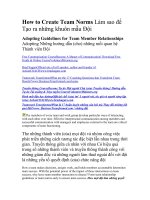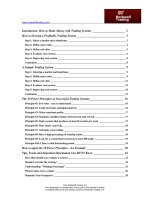Tài liệu How to Sell a ColleCtor Car docx
Bạn đang xem bản rút gọn của tài liệu. Xem và tải ngay bản đầy đủ của tài liệu tại đây (571.75 KB, 16 trang )
How to Sell a
ColleCtor Car
Whether you’re dealing with cars or widgets,
selling anything requires planning and effort.
Unless the main goal is to move your car out of
the garage as quickly as possible, selling it for
market price may take a little time. The basic
steps to selling are:
1. Prepare the car to be sold
• Complete any necessary mechanical work
• Complete any necessary cosmetic work
• Detail the car inside and out
• Gather all spare parts going with the car
• Collect all relevant paperwork and records
• Take good photos of exterior, interior and engine
2. Set a target price for the vehicle
3. Prepare the marketing plan
• Where, how and when the sale will happen
• What is needed to make it happen
4. Put the marketing and advertising to work
5. Close the sale
6. Get paid
Collector cars come in so many dierent types, styles
and shapes that to be truly successful at selling a car, it’s
necessary to tailor your selling approach to the particu-
lar car. e goal is to sell the car, but you want to get
top dollar.
STEP 1: PREPARE THE CAR TO BE SOLD
Preparing your car to be sold is a fairly self-
explanatory process.
You need to make sure it’s in top mechanical order,
clean it thoroughlyand put it someplace highly visible.
Of course, you can sell a car without doing these things,
but they almost always pay o. e easier you make it
for buyers to say yes, the faster the car will sell, and the
more money it will command.
KEY POINT
Properly preparing your car for sale will help you
sell it faster and get more money.
e more valuable your car and the better its overall
condition, the more obvious small defects will be when
a savvy buyer carefully inspects it. So make sure to care-
fully detail it, or go to a professional detailer. But with a
parts car, this is unnecessary.
e only exception is with an all-original car. It needs
to look original, especially when it’s been stored a long
time, is in exceptionally good original condition or has
exceptionally low mileage. Serious collectors will often
want to do any heavy cleaning themselves, but you may
want to clean the worst of the dirt and grime to make it
easier to properly evaluate the vehicle.
Once you’ve made the car as presentable as possible, it’s
time to photograph the car so you have images to use in
ads, for auction purposes or to send to possible buyers.
It doesn’t matter whether you use a digital or lm cam-
era, as long as your photos are available both ways.
Tips and techniques on photographing your car are
covered in the Hagerty pamphlet Ten Tips for Great
Automotive Photography, which you may request by
calling the Ask Hagerty Concierge Service at 888-310-
8020, option 3. Or download a copy by clicking on
Freebies at www.hagerty.com/library.
is is also the time to gather all the paperwork and
documentation for the car. Ownership documents, old
receipts, photographs and other items accumulated over
the years should be compiled so they can be inspected
by or oered to a purchaser.
!
STEP 2: PRICING YOUR CAR
A critical preparatory step is to set your price.
Valuing and pricing, although related, are not
the same.
e value of any car refers to the market’s view of
what a similar model is worth. When pricing your
car, you need to take into account values of what
similar examples have sold for, as well as many other
factors, including:
• e need to sell: Do you need to sell quickly?
• e overall market: Is the market for collector cars –
or more specically your car – rising, holding steady
or sinking?
• e popularity of the car you’re selling: Is it the
current must-have collectible or one that doesn’t
click with buyers today?
• Current market value: What is the current
market value?
• Condition of the car: What is the honest condition
of your car?
If you’re in a rush to sell and have a car that isn’t one of
the market darlings or is in rough condition, it’s gener-
ally best to price it close to the market value and be
prepared to take market or less to make a deal happen
quickly. But if your car is one of the current hot sellers,
you could probably get away with pricing it 10 to 20
percent over the market.
A little common sense and some research on the current
market will go a long way to helping you price your car
more eectively; check auction results and price guides
for similar cars. If you’re unsure on pricing, you may
want to hire a professional appraiser who specializes in
collector vehicles. For a detailed list of appraisers, visit
www.hagerty.com/resources. You can also nd apprais-
ers through a web search or by looking through Hem-
mings Motor News or other collector car publications.
KEY POINT
When you set your asking price, make sure that you
also know the lowest price that you can possibly ac-
cept for your vehicle.
STEPS 3 AND 4: PREPARE AND EXECUTE
THE MARKETING PLAN
The potential ways that you can sell a car vary,
and each will offer its own advantages and
disadvantages while requiring different styles.
Preparing to market a car involves four steps:
1. How you’re going to sell. Choose one or a
combination of selling methods:
• Dealer or broker
• Print and online advertising
• Live and online auctions
• Word of mouth
• Car corral or car show
2. How you’re going to market and advertise:
• Where to advertise
•Which auction, dealer or broker,
car show or website
3. Preparing the appropriate materials:
•Writing ads
•Preparing online description
•Creating signs
4. Execute the marketing plan you’ve come
up with by:
•Placing ads
•Signing auction or dealer consignment forms
•Submitting online listings
!
Dealer or Broker
Consigning your car to a dealer or broker is simple. You
either grant an exclusive or a non-exclusive right to sell
your car to the dealer or broker of your choice. e cost
of this option varies but is generally negotiable. A dealer
is typically a licensed establishment with a permanent
location or showroom that is open to the public. Brokers
may or may not have a showroom, but tend to make
connections between buyers and sellers based on their
knowledge of the market and who wants to sell or buy
at that moment. Both can make the selling process
easier by handling the marketing, transfering the funds,
dealing with paperwork and even transporting the car.
e services available are limited only by the choice of
dealer or broker.
Advertising
For most people, advertising a car for sale means classi-
ed advertising. Classied ads can be broken into two
categories: print and online. Both are good ways to sell
a vehicle, although in many cases online advertising can
reach a wider audience. No matter which you choose,
the idea behind classied advertising is to attract poten-
tial purchasers to your car, not to sell them the car with
your ad. Selling is your job and is done when you talk
to or meet with potential purchasers.
ere are several types of media to consider when
advertising a car for sale:
• Newspapers: local, regional, national
• Classified publications: Hemmings Motor News,
AutoTrader, Old Cars Weekly
• Magazines with classified sections: Car Collector,
Sports Car Market, Robb Report, club publications
• Newsletters: local and national clubs, specialty
publications
• Online: www.hemmings.com, www.autotrader.com,
marque-specic sites
Sometimes there’s a temptation to advertise a collector
vehicle in a local newspaper. But for the most part, any
perceived convenience or economy is overshadowed by
a small number of potential buyers. A national or inter-
national ad will greatly increase your chances of getting
top dollar for your car.
Print ads have long since ceased to be your only viable
option for selling a collector vehicle. e Internet ac-
counts for such a large portion of the marketplace for
any product that you avoid it at your peril. You don’t
have to make an either/or decision; most print media
with classieds oer an online version. Many oer
package deals that will cover print and online ads for
one price and one submission. If you don’t see this op-
tion oered, ask when placing your ad.
Auctions
Just like advertising, the auction market is now split
between live and online auctions. Both options can
be eective.
Online Auctions
Online auctions are the new kids on the block for
selling cars. Although there are several sites that handle
online car auctions, eBay Motors at www.motors.ebay.
com is the most widely used and recognized. An online
auction allows you to reach a wide audience of potential
buyers, is less costly than sending a car to a live auction,
and combines many of the best features of a private
sale with sending a car to auction. For tips on selling
your car online and using the online auction process,
call the Ask Hagerty Concierge Service at 888-310-
8020, menu option 3 to request a copy of Buying and
Selling Online. Or visit the Freebies section of www.
hagerty.com/library to download a copy.
Live Auctions
Choosing the auction company and which auction to
attend can be a daunting task. Auction houses generally
earn reputations for selling specic types of cars, while
certain auctions they hold tend to specialize even more.
• Barrett-Jackson – www.barrett-jackson.com
• Bonhams & Butterelds – www.bonhams.com
• Christie’s International – www.christies.com
• Gooding & Company – www.goodingco.com
• Kruse International – www.kruse.com
• Mecum Collector Car Auctioneers –
www.mecumauction.com
• RM Auctions – www.rmauctions.com
• Russo and Steele – www.russoandsteele.com
• Silver Auctions – www.silverauctions.com
• Worldwide Group Auctioneers –
www.wwgauctions.com
• Other regional companies
For example, Mecum Auctions is known for selling
muscle cars, but they also have several all-Corvette auc-
tions. e only way to learn these dierences is to ex-
perience auctions rsthand or talk with collectors who
have. It may be more cost eective to send a pre-World
War II classic car to a sale 2,000 miles from your home
to an auction known for cars similar to yours. Although
a local auction may seem like a good idea, if the sale
specializes in cars very dierent than yours – like street
rods and muscle cars – it will attract an audience that
won’t be interested in your car. In general, a car that is
out of character for an auction will bring a much lower
price. Only experience or research will point you in the
right direction.
e owner of this 1966 Oldsmobile Toronado gured
that the car corral at the AACA’s Fall National Meet in
Hershey, Pennsylvania, was a great way to expose it to
tens of thousands of potential buyers.
KEY POINT
Do a lot of homework before consigning your car
to an auction. Each auction company has different
strengths, so you need to pick a company and a venue
that is best suited to the type of car you’re selling.
Word of Mouth
Another option to consider when selling your car is
word of mouth. Car collecting represents a relatively
tight community, and the interconnections between its
members can be very useful. When it comes time to sell
your car, tell friends and other collectors with a shared
interest that it’s for sale. Part of the magic of the collec-
tor car hobby is that if you tell fellow enthusiasts
you’re selling your car, they’ll tell their friends who
share the same interests and so on. It’s not unusual for
a car to sell on word of mouth alone when the informa-
tion is passed to the appropriate people.
Car Shows & Car Corrals
Taking your car to shows and car corrals also helps to
get it in front of potential buyers. Most car shows don’t
allow cars for sale on the show eld, so you’ll want to
rent a space at the car corral and put a For Sale sign on
it. With a eld full of potential buyers, and most likely
a bunch interested in your specic marque, a car show
is a perfect venue to sell a car. Interacting with potential
purchasers from the rst moment can be an eective
sales tool and result in a quick sale. Costs for car corral
spaces can vary, but for a well-attended show, particu-
larly one that focuses on your marque or type of car,
the cost is negligible. Create a yer detailing the car’s
attributes that you’ll have on hand to give to interested
people; include your contact information.
!
Advertising Copy
You should read ads for cars like yours in the publica-
tions or online media you plan to use so you under-
stand the styles and techniques used.
Here are the basic guidelines for writing ads:
• Keep it clear and concise: Print ad prices are
usually determined by the word or line, so keep the
description short, but provide enough information
to pique the reader’s interest. Hit the high points,
be honest about any problems, and keep your tone
positive. Some publications will allow the online
ad to be lengthier than its print counterpart, as
space is not a factor.
• Include the basics:
– Year
– Make
– Model
– Exterior color
– Interior color
– Engine type and size
– Mileage
– Major options and original equipment condition
– Price
– Phone number
– E-mail address
– State where car is located
• Photos: Photos are a big attention-getter, especially
if they’re optional in the publication. For a print ad,
properly exposed three-quarter views should be used.
If you have additional photos available, posted online
or at a dierent web address from the ad, include that
information. Even if you can only run a single image
in a print ad, you should have a variety of images to
post online or send to potential buyers:
– Front three-quarter view
– Rear three-quarter view
– Front
– Rear
– Side
– Engine compartment
– Interior
– Any signicant aws
KEY POINT
Never exaggerate or misrepresent a car you’re
selling. If you do, it could come back to haunt you.
Ad Placement
Classied advertising is eective both economically
and in results – so long as it targets the proper audi-
ence. Focusing on publications that provide the greatest
number of potential buyers is a sound basic strategy.
Target markets include the car collecting world in gen-
eral, typically reached by Hemmings Motor News, Old
Car Trader, Car Collector, Old Cars Weekly and Antique
Automobile to name a few. However, if you’re selling
a 1950 Ford truck, a more focused audience can be
reached by advertising in the Double Clutch, published
by the Antique Truck Club, or the V8 Times, published
by the Early Ford V8 Club. Placing ads in dierent
publications, both general interest and club-oriented,
usually guarantees the widest audience.
If you aren’t a regular reader of these publications, bor-
row or purchase a few issues to determine the one that
best suits your needs. Comparing costs may help. But
sometimes the more expensive ad will produce better
results, so examine your choices carefully. Talking with
other collectors who have placed ads will often give you
insight into the best choice.
Whether you’re trying to
sell a vehicle online or need
photos to send to someone
responding to a classied ad,
be sure to cover all angles.
Don’t forget to throw in the
engine compartment and
interior, too.
!
STEPS 5 AND 6: CLOSING THE SALE
AND GETTING PAID
The acts of selling and closing a sale are the
subjects of many books, but it’s your job to get
potential buyers to say yes and agree to a price
with which you are comfortable.
Once the deal is sealed, the big issue is making
certain you get paid and that the transaction is com-
pleted without hassle.
Let the Seller Beware
e majority of collector car hobbyists are honest.
However, you’ll need to be on the lookout for dis-
honest, manipulative and conniving people who
are also part of the hobby. Such people make a habit
of preying on unsuspecting folks and, unfortunately,
the possibilities for fraud are limited only by the imagi-
nation of the individual seeking to commit it. Consider
these possibilities:
• You oer your car for sale in an online ad. Someone
sees your car, takes your ad and puts your car on eBay
Motors without your knowledge. ey either collect
the money from the winning bidder on eBay and
disappear, or they buy the car from you and sell it
to the winning bidder, pocketing the dierence.
Both transactions involve some level of fraud.
• Another scam can be combined with the previous
one: Someone buys your car with a bogus payment
such as a phony bank check or money order, coun-
terfeit bills or a bad personal check. If they buy your
car this way and sell it right away, they can disappear
before you realize that the payment is no good.
• An interested potential purchaser comes to buy
your car, but while you’re chatting, this person
holds you up and takes your car – along with the
title or paperwork.
• It doesn’t happen often, but collector cars have
been stolen during test drives – especially when you
get out of the driver’s seat and the buyer gets in.
As a result, never let an interested buyer take a test
drive without you.
ese may sound far-fetched, but every one of these
scenarios has happened. e point is to practice self
security. To protect yourself, do the following:
• Ask callers where they heard about the car
• Get contact information from interested callers
• Arrange to have friends with you when you
meet with strangers
• Verify your funds before turning over the car
or paperwork
• Be choosy about payment methods you’ll accept
Payment options include:
• Cash: Generally safe, but check bills for counterfeits;
bill-checking pens are available at stationery stores.
• Personal check or certified check: Hold the car until
the bank conrms that the funds are in your account.
Certied checks don’t oer any more protection for
sellers than a personal check.
• Bank or cashier’s check: is is safe, as long as the
check is from a real bank. It’s a good idea to call the
bank to verify that the check was issued or to have
your bank verify the funds. Better yet, deposit the
check and let it clear before you release the car.
• Wire transfer or electronic payment: A direct
transfer of funds from one nancial institution
directly to another is one of the most certain forms of
payment. Contact your bank to ensure that funds are
in your account before you release the car.
With a little preplanning and discussion with your
purchaser, you should be able to arrange for secure pay-
ment that allows the buyer to take possession of the car
quickly while minimizing the risk to both parties.
KEY POINT
Never let a prospective buyer drive your car without
you. If a buyer and his “expert” both want to drive
a two-seat car, take them each out separately, but
never give them the opportunity to disappear with
your car.
Bill of Sale
One of the safety steps that are often overlooked is to
prepare and execute a bill of sale or sales receipt.
e basics for a bill of sale include:
• Seller’s identification: Name, address, phone
number and driver’s license number. You may also
want to provide your e-mail address.
• Buyer’s identification: Name, address, phone number
and driver’s license number, which may be required
in some states. Be sure to physically review the buyer’s
driver’s license and verify the address. You may also
want to include the buyer’s e-mail address.
• Proper identification of the car: Year, make, model,
VIN, any descriptive items, and any extras included
in the deal.
• e purchase price: Show the total for the deal, plus
make note if a deposit was made and the balance due.
Never list a lower or false price.
• Warranty statement: State if any warranty goes with
the car. Most private sales would indicate the car is
sold “as-is, where-is with no warranty.”
• Signatures and date: All parties should sign and date
the bill of sale.
Some states require a copy of the driver’s license to
transfer a car. So it may make sense to include the
driver’s license numbers on the bill of sale.
!
I, (Seller’s name:)_______________________________, hereby certify that I
am the lawful owner of this vehicle:
Year ________Make ______________________Model __________________
VIN#__________________________________
and have the authority to sell it. I hereby acknowledge the receipt of $________
in the form of _____________, from (Buyer’s name:)____________________,
as full payment for the purchase of the said vehicle, which is sold “AS IS.” I
hereby state that the mileage of the vehicle at the time of sale is ____________.
I do hereby grant, sell and transfer full ownership of this vehicle to the Buyer. I
certify that this vehicle, at the time of sale, is free from all encumbrances, taxes,
fees and liens except as those specied on the title or listed below; and that, I
will defend and be held fully responsible for such lawful claims and demands
with respect to the vehicle, if any.
Buyer accepts full liability for the vehicle, damages, and any third-party liability
incurred from the vehicle use from the date of sale.
If applicable, Seller agrees to make arrangements for the reasonable delivery of
vehicle title from lien holder to Buyer immediately.
Seller’s Signature Date
Buyer’s Signature Date
Buyer’s Identication:
Name:
Address:
Phone:
E-mail:
Seller’s Identication:
Name:
Address:
Phone:
E-mail:
KEY POINT
No matter how well you know or like a buyer, never
complete a deal to sell a car on a handshake alone.
Make sure you have a detailed bill of sale that
accurately lists the buyer’s and seller’s addresses,
plus reports the property and the money that changes
hands. If the deal gets messy, an accurate bill of sale
could be a very important tool.
Once you’ve been paid in full for the vehicle, it’s time
to sign the title over to the car’s new owner. Now your
mission is complete, and it’s time to bank the money
and start the search for your next collector vehicle.
Bill of sale requirements vary by state. Check with your DMV
or Secretary of State, consult with an attorney or visit a site
such as www.uslegal.com for details.
!
2006-282
This material is for information purposes only and is not a substitute for professional advice.
The information is obtained from sources believed to be accurate and reliable, but no
guarantee is made that it will be sufficient or appropriate for every individual or situation.
© 2007 HagertyPlus, LLC. For copy and reprint permission, contact
Hagerty is the premier source for safety and
protection information about the collector
car hobby. For more information on enhancing
your collector car ownership experience, log
on to www.hagerty.com or call 800-922-4050.









